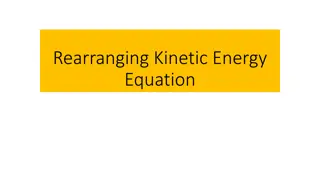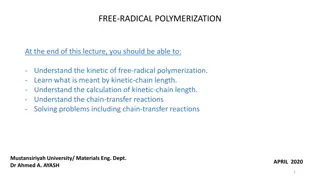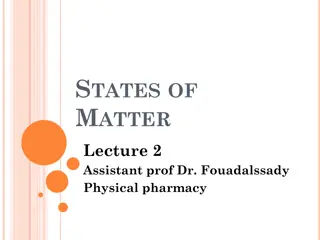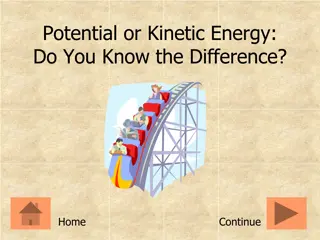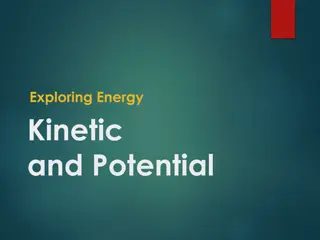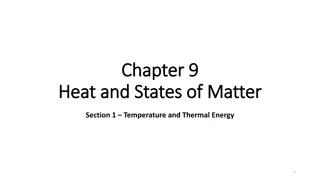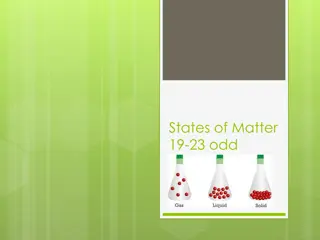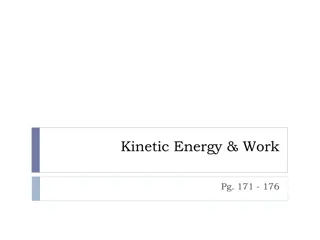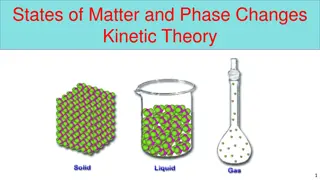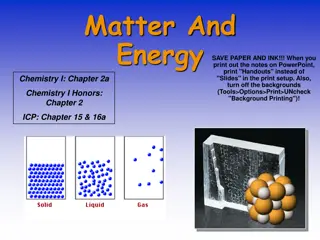Understanding States of Matter and Kinetic Theory
Matter is anything that occupies space and has mass, existing in solid, liquid, gas, and plasma states. The states of matter depend on the arrangement and motion of atoms. Solids have fixed shapes, liquids take the shape of their container, and gases fill the volume of their container. The Kinetic Theory of Matter explains that particles are in constant motion and their speed increases with higher temperatures. Heat is the transfer of energy between objects of different temperatures. Solids have definite shapes, liquids flow, and gases expand to fill available space. Crystalline solids have particles arranged in repeating patterns.
Download Presentation

Please find below an Image/Link to download the presentation.
The content on the website is provided AS IS for your information and personal use only. It may not be sold, licensed, or shared on other websites without obtaining consent from the author. Download presentation by click this link. If you encounter any issues during the download, it is possible that the publisher has removed the file from their server.
E N D
Presentation Transcript
Matter What is Matter? Anything that takes up space and has mass Made up of atoms or molecules Exists as three states(solid, liquid, gas) **plasma as fourth state
Why are there different states of matter? Depends on how their atoms are arranged and how they move
Solids: particles are tightly packed and move slowly Liquids: particles are held together, but not in a fixed position; particles move at a moderate speed Gases: particles are spread apart and move quickly
Kinetic Theory of Matter All particles of matter are in constant random motion (Brownian motion) Particles move due to kinetic energy Amount of kinetic energy is measured by temperature The greater the temperature, the faster the particles Particles stop moving at absolute zero (-273.15 C)
Difference between heat and temperature Heat is the transfer of energy from higher temperatures to lower temperatures Ex: An ice cube melts in your hand because the energy from your hand is transferred to the ice cube
Solids Definite or fixed shape Definite volume Particles are arranged closely together Low kinetic energy; particles move slowly Can be crystalline or non-crystalline (amorphous)
Liquids Definite volume Takes shape of it s container Particles are held together but not in a fixed shape Fluid-flows freely Moderate kinetic energy; particles move at a moderate speed
Gases Fluid Changes volume No definite shape Particles are far apart Particles spread out until they hit a barrier High kinetic energy; molecules are moving quickly
Crystalline Non-crystalline Particles are arranged in repeating geometric patterns Geometry of the crystals depends on size and number of particles Crystals are usually not very large Examples include: diamonds, salt, sugar, snow Crystal structures break down when melted Definite melting point Also called amorphous Have no definite pattern or form Large molecules are stuck in a random arrangement Examples include: glass, plastic No definite melting point; just get softer and softer Solids
Phase Changes Sublimation Melting Boiling/Evaporating Temp increased Temp increased Water Vapor Temp decreased Ice Water Temp decreased Condensing Freezing
Changes of State A substance changes states when energy levels increase or decrease significantly by the addition or removal of heat. As temperature increases, energy levels increase. As temperature decreases, energy levels decrease.
Changes between a Solid and Liquid Melting change in state from a solid to a liquid added thermal energy (heat) makes water molecules vibrate faster causing them to break free from their fixed position. melting point of water = 0 C Freezing change in state from a liquid to a solid removal of heat causes water molecules to slow down and form into a fixed position. freezing point of water = 0 C
Changes Between Liquids and Gases Condensation occurs when particles of a gas lose enough thermal energy to change back into a liquid Vaporization (boiling/evaporation) occurs when the particles in a liquid gain enough thermal energy to form a gas.
Two Types of Vaporization Evaporation takes place only on the surface of a liquid Water gains energy from ground, air, or sun Boiling liquid turns to a gas below the surface and at the surface; forms bubbles throughout boiling point of water = 100 C (at sea level)
Changes between a solid and gas Sublimation Particles of a solid gain enough energy to form directly into a gas without forming a liquid first Example: dry ice



